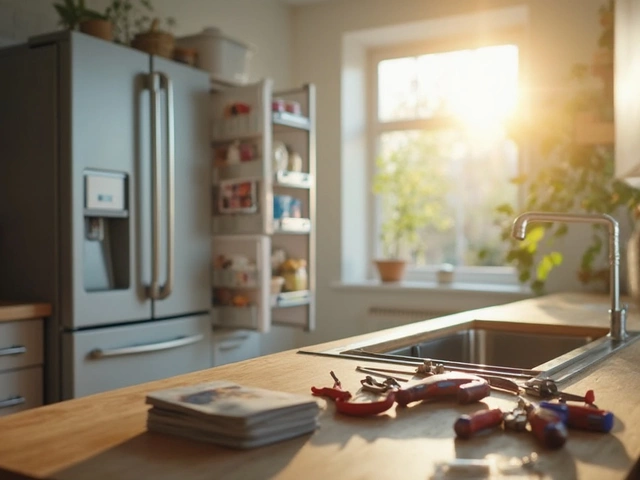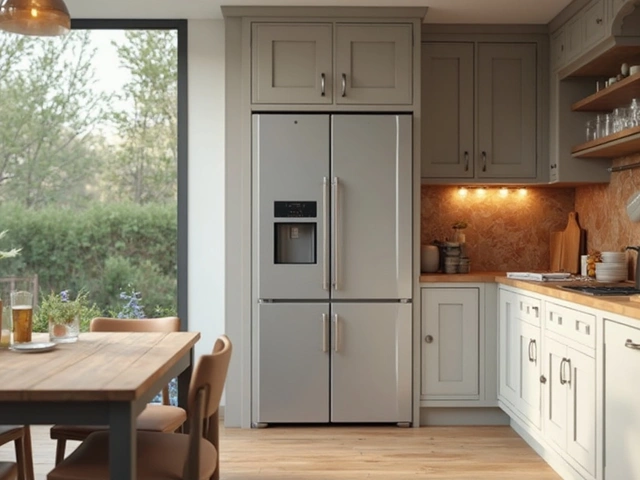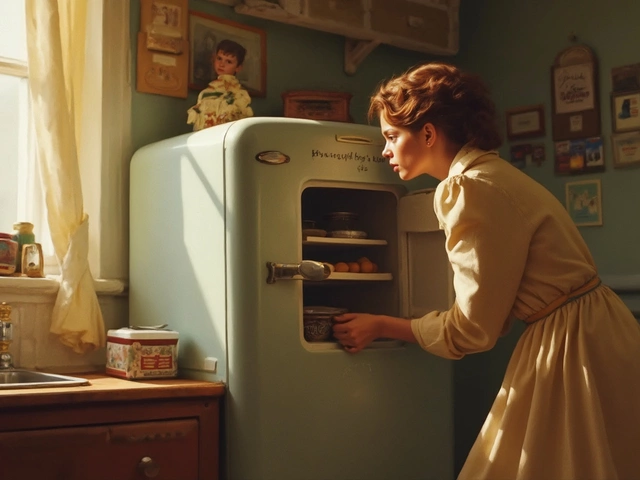So, your fridge is on the fritz again. Maybe it’s making some weird noises, or nothing inside is as cold as it should be. Now you’re stuck wondering whether to call a repair guy or just start fresh with a shiny new model down at the appliance store.
First off, don’t worry. You’re not alone in this fridge funk. Plenty of folks end up scratching their heads trying to figure out whether to repair or replace. The trick here is knowing a few key things about your refrigerator's age, common issues, and the cost of both options. That way, you can make a smart choice without any regrets.
Did you know most refrigerators last between 10 to 15 years? Yeah, if your fridge is acting up and it's nearing that age, it might be ready for retirement. But if it's still a young buck, a repair could add lots more years to its life.
- Understanding the Lifespan of a Refrigerator
- Common Refrigerator Issues and Costs
- When Repairing Makes More Sense
- Signs It's Time to Replace
- Tips for Extending Your Fridge’s Life
Understanding the Lifespan of a Refrigerator
Let's talk about those metal boxes that quietly hum away in your kitchen—the good old fridge. Most people don't give them much thought until something goes wrong, but knowing the typical lifespan of a refrigerator can really help in making smarter decisions about whether to go for fridge repair or not.
So, how long do these appliances usually last? Generally, a refrigerator's lifespan spans anywhere from 10 to 15 years. Of course, that can vary based on the make, model, and just how much TLC it’s received over the years. If your unit is pushing the 15-year mark, it might be well past its prime and edging towards retirement.
Now, different types of refrigerators have different average lifespans. Top-freezer models? Usually at the longer end of the spectrum, sometimes clocking up to 20 years if you’re lucky. Side-by-sides or ones with all those fancy features probably won’t hang in there as long, often topping out around 14 years.
| Type | Average Lifespan |
|---|---|
| Top-Freezer | 15-20 years |
| Side-by-Side | 12-14 years |
| Bottom-Freezer | 12-15 years |
But here's where things get interesting—maintenance is key. Regular cleaning, both inside and out, can actually bump up your appliance’s lifespan. Dusty coils and clogged vents are like kryptonite to fridges, causing them to work overtime, which shortens their lives. So, pulling it out once in a while to spruce it up can do wonders.
Of course, how you use it also matters a lot. Stuffing it to the brim all the time or constantly leaving the door open means it has to work harder, which can shave off precious years. Taking good care of your refrigerator is definitely worth it, especially when you’re trying to decide on refrigerator replacement.
Common Refrigerator Issues and Costs
Before you start fretting over whether to repair or replace, let's chat about what could actually go wrong with your fridge. Some issues are minor and cheap to fix, while others might make you want to toss the whole thing and start over.
One of the most common hiccups is a broken ice maker. Even though it feels like a luxury that's gone rogue, it's actually a pretty frequent complaint. Repairing an ice maker could set you back about $150 to $250, depending on your fridge model.
Another classic issue? Fridge not cooling. Imagine warm milk and wilting veggies. Not good, right? This could be due to a faulty thermostat or condenser coil problems. Repairs here can cost around $200 but might shoot up if things get complicated.
Let's not forget about water leakages, which can leave you with a mini pond in the kitchen. Leaks often come from a clogged defrost drain or a worn door seal, with repair costs averaging between $100 and $150.
| Issue | Potential Cost |
|---|---|
| Ice Maker Repair | $150 - $250 |
| Cooling Issues | $200+ |
| Water Leakage | $100 - $150 |
Now, there's no shortage of tips and tricks from the experts. One refrigeration technician, John Smith, says, "Sometimes small glitches aren’t worth the call-out fee. Simple fixes like defrosting or cleaning vents might solve your problem."
"When in doubt, focus on the overall health of your appliance. If repair costs inch toward half the price of a new refrigerator, it might be time to start shopping," advises Kelley Dunn, a seasoned appliance advisor.
Bottom line? Pay attention to these refrigerator issues and repair costs. They’ll give you a better grip on whether you're better off fixing the problem or heading out for a replacement.

When Repairing Makes More Sense
Alright, so let's get into why you might want to stick with fixing that fridge instead of tossing it to the curb. If we're talking repair costs that are less than half the price of a new model, it's usually a no-brainer to call in the repair guy. Got a busted compressor or a faulty thermostat? Surprisingly, these aren't the end of the world and can often be fixed up at a fraction of a new fridge's cost.
Older but reliable brands can be real workhorses. If yours falls in this camp, then a quick repair could keep it humming along for years to come. Plus, if the refrigerator hasn't hit the 10-year mark yet, chances are it just needs a bit of TLC rather than a full replacement.
On top of that, if you've got some sentimental attachment to your appliance (hey, it’s possible!), or you've invested in a built-in model that perfectly matches your kitchen, repairs make a lot more sense.
| Common Issues | Repair Costs |
|---|---|
| Compressor Replacement | $200 – $450 |
| Thermostat Repair | $100 – $200 |
| Door Seal | $50 – $80 |
Here’s a simple guideline: if that trusty fridge of yours is still doing its main job—keeping food cold without guzzling too much energy—give repairs a shot. Compare that with the juicy price tag of a new fridge, and you might find fixing what you’ve got is a sweeter deal.
Another point? Energy efficiency. If your refrigerator is already relatively efficient, newer models might not offer substantial savings in utility bills. In that case, sticking with what you have saves money and spares the planet from additional manufacturing and shipping costs.
So, weigh your options carefully. The sentimental value, plus some cost-saving math, can make fixing your current fridge a no-brainer.
Signs It's Time to Replace
Alright, if your refrigerator is causing you more grief than a two-year-old with a sugar rush, it might be time to say goodbye. But how do you know it’s really time for a new one?
First thing’s first, consider the age. Most refrigerators last about 10 to 15 years. If yours is already past its teenage years, replacing it might actually save you more money in the long run due to energy efficiency and fewer repairs.
Next up, if your fridge is constantly making weird noises louder than a garage band, that’s a huge red flag. Yeah, you might adjust to the symphony of clanks and clunks, but it means your fridge’s components are struggling.
Another sign? Check your electricity bills. If your bills are mysteriously getting higher and higher, your fridge might be the culprit. Older fridges are usually less energy efficient compared to newer models. So, swapping it out could cut those costs quickly.
- Frequent repairs: If it feels like every other month you’re calling the repair service, it’s time to evaluate whether a new refrigerator might cost less than all those repairs.
- Inefficiency in cooling: If your fridge isn’t keeping things as cold as it’s supposed to, even after you've messed with the temperature settings, it’s likely running out of steam.
- Visible signs of wear: Things like rust on the exterior, broken shelves, or door seals that have lost their grip are more than just aesthetic problems. They can mean it’s time for an upgrade.
Here's a helpful stat: A new fridge can use up to 70% less energy compared to one that's 20 years old. Imagine what you could do with the money saved from lower energy bills over a year or two!
If you notice these signs, it might be time to stroll over to the appliance aisle. Sure, buying a new fridge isn’t the most fun way to spend your Saturday, but it beats living with a faulty fridge any day.

Tips for Extending Your Fridge’s Life
Taking care of your fridge can make a huge difference in how long it lasts. It doesn't have to be rocket science either. A few simple habits can really stretch out those years before you have to consider a refrigerator replacement.
Start with the basics—clean the coils. Dust and grime can build up on the coils at the back or bottom of your fridge, making it work extra hard to keep things cool. Unplug the fridge and use a vacuum or a brush to gently clear the dirt at least twice a year.
Next, keep that fridge door closed as much as possible. Every time you swing it open, cold air rushes out and it has to work overtime to chill things down again. Remember to avoid blocking the vents inside too, so your fridge has great airflow.
Don’t forget to check the door seals. Over time, those seals can wear out, letting cold air escape. An easy way to test it is by putting a dollar bill in the door. If you can pull it out easily with the door shut, it might be time for a new seal.
If your appliance has an ice maker or water dispenser, make sure to replace the filter regularly. Doing this helps keep the water tasting fresh and ensures the mechanisms inside don’t get clogged up with gunk.
- Temperature settings matter. Keep your refrigerator around 37 to 40 degrees Fahrenheit and the freezer at 0 degrees.
- Consider setting your fridge in a place where it's got good ventilation and isn’t too close to heat sources like ovens or direct sunlight.
By following these simple pointers, not only will you save on those pesky fridge repair bills, but you'll also help your fridge run more efficiently, saving on energy costs too.




